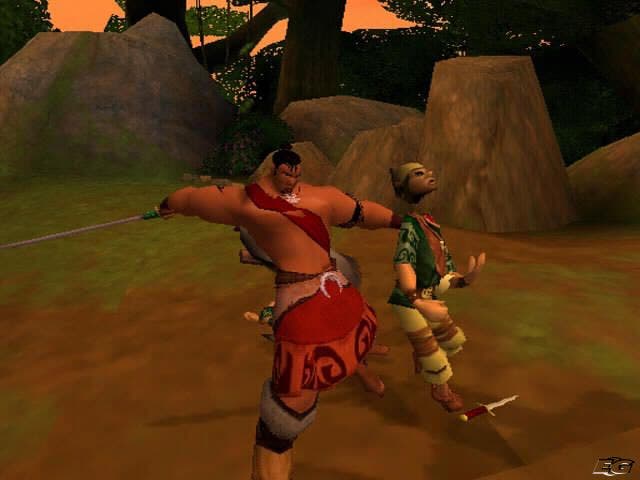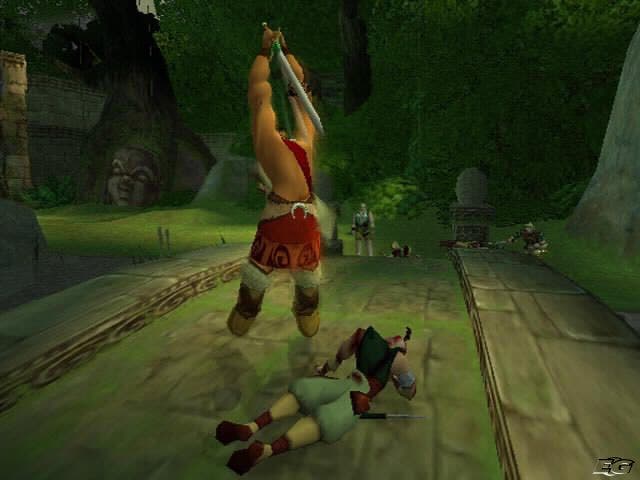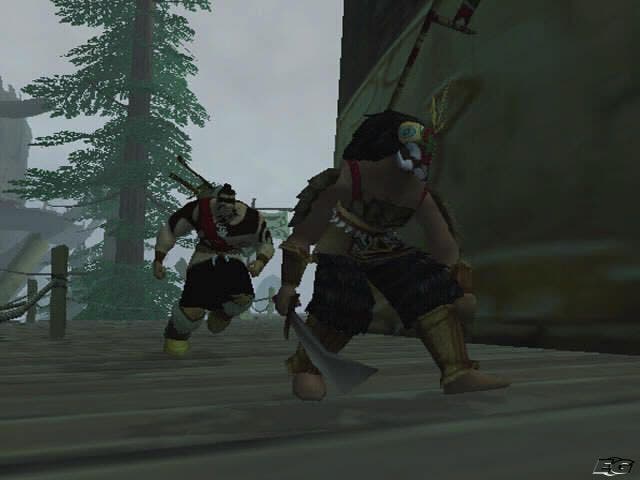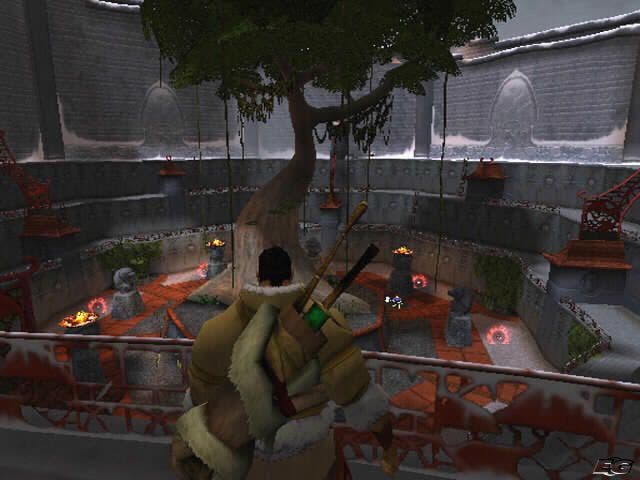The Mark of Kri
Review - Tom really liked the look of this one last month, but does it hold up against further scrutiny?
Cartoon violence is a difficult subject to tackle. Broadly speaking, we have two different schools of thought. On the one hand, people will often argue that cel or toon shading and similar techniques detach games like GTA from reality, and thus exclude them from the sort of Commons witch-hunts we've seen in the past. "Why not focus on more brutally realistic titles like The Getaway and their wanton take on real-life violence," Vercetti followers may bitterly muse.
On the other hand, when it comes to games like The Mark of Kri, visually akin to the average 90s Disney flick, and its nauseatingly vivid realisation of bone-shattering stealth kills and bloody slaughter, some would say that the effect is worsened. After all, it's an invasion of a kiddy medium - and how would Mummy's little urchins react if, instead of a slapping Khan into a fiery chasm, Simba had pulled out a sword and stuck it through his uncle's face?
Fortunately for you, we're not here to preach one way or the other - we just want to tell you about the game - but you might want to take it into consideration if you like playing PS2 with your nippers crawling around on the carpet. This isn't one for the faint of heart, despite its Disneying pretence.

The path to enlightenment
Ya see; The Mark of Kri is a traditional but very bloody slasher at heart, with a burly, almost husky hero named Rau whose grunts and brutality belie his apparently moralistic tendencies. At the start of the game, Rau is a rogue, untested warrior, and when the local barkeep asks this inexperienced but highly talented young swordsman to rid the surrounding forest area of its crooks and bandits, he duly agrees, and having done so thenceforth a further five quests will drop into his lap, thanks to characters or events at the tavern.
But after accepting a dubious quest and earning a bag of cursed change, Rau decides not to take money in spite of conscience in future, and his path becomes more righteous, leading him through forests full of evildoers, Ewok village-style treetop mazes, on quests through stonewashed environments ripped straight out of Greek mythology, and into the company of some sort of bizarre LSD-fruit-spitting oracle tree. All in the name of vanquishing the mystical Mark of Kri, which blights its bearers and could bring doom to the world. Blimey.
In all, it's a simple, fairly linear adventure which sees Rau journey around complex but predictable environments picking off set clusters of enemies in the various ways the developer intended. When faced with enemies, the player whirls the right analogue stick around and an ethereal orange dingdong tags up to three enemies (or up to six or nine enemies later on) with different button labels. Pressing the corresponding button (X, square or circle) will attack that specific enemy, and depending on the size of your weapon [enough -Ed] and the manner in which Rau elects to swing it, may well splash damage several others. Double and triple tapping of each button will perform combos, and if you only have two or even just one enemy tagged, you can use the remaining unassigned attack buttons to modify your combos, or just swing the dingdong out again to tag some more. Wherever they are, front, back, or side, Rau will attack.
It sounds a bit complicated, but your whale of a coach Baumusu will teach you how to do all this before you start, and teach you some brutal new attack or offer up an advanced weapon for each of the game's six levels. Finish level one, and you'll be taught about stealth kills. Finish level two, and you'll learn the ways of an archer. Etc.

One kill to rule them all
Sadly though, the two most interesting aspects of the combat system are stealth kills and disarm manoeuvres. It's sad because once you get to grips with these, the task of hacking and slashing your way through the opposition (which takes much longer and is much more damaging than anything else) seems largely worthless and is saved only for the final level where Rau is besieged by relentless hordes of zombies. You won't pull off as many of the special combos that Baumusu's Challenge demands in exchange for DVD-style extras, but you won't get bored of dying over and over, either.
So unless an enemy unavoidably sees you, or needs to be sniped with your bow from a distance and can't be (due to armour), you'll want to perform a stealth kill - done by sneaking up slowly behind him, using the prosthetic dingdong [Who is this guy? Mark Wahlberg? - Ed] to tag him and up to two pals as usual, and then waiting for the button label above his head to stop flashing so that you can press it (and any others in sequence) to get a swift, Tenchu-esque stealth kill.
Alternatively, if you are forced into combat, you'll quickly learn to rely on the disarm technique of hitting R1 as an enemy throws an attack. Doing so sees you nab his weapon and then perform the technical equivalent of a stealth kill - a swift, decisive manoeuvre with a brutal accompanying animation. A few tries and you'll be able to do this for most situations where enemies queue up in small groups.

You look Tench, you
Getting back to stealth kills though, we do mean 'Tenchu-esque'. One of the things which struck me as odd, when we finally had playable copies of both games in our possession (about a fortnight ago), was how similar their stealth kill mechanics are. In the case of Tenchu, the whole game is largely given over to leaping from rooftops and ducking out from the shadows to slice, dice and crack skulls, but on the whole you do just find an enemy, wait for him to turn away and then dive in with an R1-plus-Y-button combo to do the job. Visually, the style of execution - a cleverly framed sequence with a vicious finale - is almost identical, which leaves the control systems, which obviously differ but work in much the same way.
However, Kri has something of an edge in the camera department, which seems a little ironic when compared to a game whose raison d'être is stealth killing. Apart from using the L1 button for stop-and-look-around camera control (same as Tenchu), you can't control it directly, and it's a burden in hand-to-hand combat, but it hops into mostly acceptable positions for stealth - particularly on roof kills, where it stands poised above the target allowing you to select him from above and then leave the entire sequence in the hands of Rau's AI from that last step off the roof onward.
Anyway, it's safe to say that both games have very rewarding systems for stealth killing, but this probably isn't why you thought you'd play The Mark of Kri, so to say that stealth killing and disarm killing are the most enjoyable activities (along with the similarly designed archery system) is surely a bit of a problem. We'd very much like to say that fighting is fun, but it isn't. You lose health rapidly, you face overwhelming odds, and it takes ages to kill even one enemy efficiently. Mercifully, by the time there's no escaping it on the final level, you're armed with the biggest and baddest weapons with a massive reach and can just decapitate all over the shop in one, sorry, 500 fell swoops. Assuming the annoying 'steal your weapons' enemy isn't about. Equally merciful is the total absence of bosses, although we were disappointed that Studio San Diego didn't seize on the areas of the game that work really well to produce some memorable boss encounters. Perhaps next time, eh?

Spit and squawk
Graphically, as we've said, it's very Disney-like, with chunky, well-defined characters, and equally chunky environments. The size of these often means they are quite spectacular, but graphically the game offers more of a GTA-style level of adequacy than Gran Turismo on horseback. There are no horses, either! There are, however, a lot of carefully thought out animations to give the stealth killing some much needed variety. You can do pretty much anything, although you haven't much control over what Rau actually does do, if you see what I mean.
Speaking of visuals, a special mention is due here for the fisheye (well, bird's eye) view that you get from Rau's spirit guide Kuzo, whose gravely voice it is narrating the story during intermissions. Kuzo is an excellent gameplay addition, allowing you to scout out the level for a better chance of stealth by flying off to distant perches - triangle is used to switch between Rau and Kuzo's respective views, to recall the bird or send him off to the next perch - and he can also operate the occasional lever or pick something up. Ok, these are arbitrary additions to make him look more important, but his main job of letting you see round corners is hugely important to your style of play.
Actually though, despite his usefulness, Kuzo almost feels like a digital apology for the boring hackandslash sections. It's as if San Diego thought they'd give you his extra set of eyes to limit the amount of time you spend walking into combat and give you more opportunities to kill stealthily. Throughout the game, Kuzo is mainly used for evasion of hackandslash activities.
One section where he is particularly important is at the end of level four, where Rau is faced with an enormous round basin, like a coliseum, with ladders, walls and enemies strategically placed so you're forced to work your way down gradually and painstakingly. It takes absolutely ages and the final showdown (on your last grain of health) with two huge axe-wielding psychos is nerve-wracking. This, we liked. Having to fight an unending, sprout-from-the-ground legion of crack zombies for a finale, we didn't.

Hidden Tuku
Where were we? Ah yes. We've tackled the combat system and its flaws, the way that you spend most of the game relying on the bits that are fun and not the bits which are expected, and that the developer pushes the cartoony graphical boat out into freshly laid seas of blood, but the one thing we really should mention above all else is the issue of brevity. The Mark of Kri takes roughly six hours to finish - a playtime so slight that we were able to complete it a second time (in four hours!) before sitting down to write this review. That's once through, start to finish, in six hours, and we located all of the so-called hidden Tukus, which (if you get them all) open up a Level Select option. Even if you do this, and complete all Baumusu's challenges and take on everything the game might have to offer beyond then, which isn't much, six hours only is not going to be enough for average so-and-so, especially during March 2003, the proverbial sequel to Christmas 2002, with massive, terrifyingly long and intricate blockbusters on every shelf.
Sure, as anybody who played ICO will happily tell you, six hours can be sheer gaming joy. But the operative there is 'can'. The Mark of Kri isn't the best game ever, and it isn't really even sure what it wants to be. As a stealth killer it's occasionally on a par with Tenchu, and fans of that will lap up the methodology behind Rau's slaughter with aplomb, but as a hackandslash alone it's on a par with Gauntlet sodding Dark Legacy - there's no compulsion to become good at the system, as you're often fighting the camera when confronted and with so many enemies it's just arduous and boring. Kri's got a lovely story though, and otherwise it is very compelling, thanks to thoughtful level design and so on, but we just don't want San Diego throwing different styles of combat into the periphery if they're going to screw up the main one.
Although we very much enjoyed The Mark of Kri, which we finished in one day, it has arrived at very much the wrong time for a game of its almost-brilliance. Tenchu: Wrath of Heaven, which sits handsomely at my side, its manual beaming at me in all its photocopied glory, tackles stealth kills almost identically, and concentrates its efforts solely on that subject. Instead of giving the rest of the game over to hackandslash tedium (which, if you can't get a handle on the 'disarm; slaughter' technique, will quickly become depressing), a bit of focus might have alleviated the problems. Our advice? Rent it, complete it, return it and wait for the sequel. If the ending's anything to go by, there will be one.








